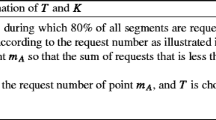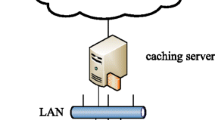Abstract
In continuous media servers, disk load can be reduced by using buffer cache. In order to utilize the saved disk bandwidth by caching, a continuous media server must employ an admission control scheme to decide whether a new client can be admitted for service without violating the requirements of clients already being serviced. A scheme providing deterministic QoS guarantees in servers using caching has already been proposed. Since, however, deterministic admission control is based on the worst case assumption, it causes the wastage of the system resources. If we can exactly predict the future available disk bandwidth, both high disk utilization and hiccup-free service are achievable. However, as the caching effect is not analytically determined, it is difficult to predict the disk load without substantial computation overhead. In this paper, we propose a statistical admission control scheme for continuous media servers where caching is used to reduce disk load. This scheme improves disk utilization and allows more streams to be serviced while maintaining near-deterministic service. The scheme, called Shortsighted Prediction Admission Control (SPAC), combines exact prediction through on-line simulation and statistical estimation using a probabilistic model of future disk load in order to reduce computation overhead. It thereby exploits the variation in disk load induced by VBR-encoded objects and the decrease in client load by caching. Through trace-driven simulations, it is demonstrated that the scheme provides near-deterministic QoS and keeps disk utilization high.
Similar content being viewed by others
References
D. Anderson, Y. Osawa, and R. Govindan, “A file system for continuous media,” ACM Transactions on Computer Systems, Vol. 10, No. 4, pp. 311–337, 1992.
P. Cao and S. Irani, “Cost-aware WWW proxy caching algorithms,” in Proc. of the USENIX Symposium on Internet Technologies and Systems, Dec. 1997, pp. 193–206.
A. Dan, R. Mukherejee, D.M. Dias, D. Sitaram, and R. Tewari, “Buffering and caching in large-scale video servers,” in Compcon-Technologies for the Information Supurhighway, Los Alamitos, CA, June 1995, pp. 217–224.
J. Gemmell and S. Christodoulakis, “Principles of delay-sensitve multimedia data storage and retrieval,” ACM Trans. of Information Systems, Vol. 10, No. 1, pp. 51–90, 1992.
J. Gemmell, H.M. Vin, D.D. Kandlur, and V. Rangan, “Multimedia storage servers: A tutorial and survey,” IEEE Computer, Vol. 28, No. 5, pp. 40–49, 1995.
S. Gollapudi and A. Zhang, “Buffer management in multimedia database systems,” in Proc. of IEEE International Conference on Multimedia Computing and Systems, Hiroshima, Japan, June 1996, pp. 186–190.
R.V. Hogg and E.A. Tanis, Probability and Statistical Inference, Prentice Hall, Eaglewood Cliffs: New Jersey, 1993.
Informatik MPEG-I Traces. ftp: //ftp-info3.informatik.uni-wuerzburg.de/pub/MPEG.
E. Knightly and H. Zhang, “Traffic characterization and switch utilization using deterministic bounding interval dependent traffic models,” in Proc. of IEEE INFOCOM '95, Boston, MA, 1995, pp. 1137–1145.
K.O. Lee, J.B. Kwon, and H.Y. Yeom, “Exploiting caching for realtime multimedia systems,” in Proc. of IEEE International Conference on Multimedia Computing and Systems, Florence, Italy, June 1999.
R.T. Ng and R. Dilek, “Statistical modeling and buffer allocation for MPEG streams,” in Multimedia Information Storage and Management, Kluwer Academic Publishing, 1996, pp. 147–162.
R.T. Ng and J. Yang, “An analysis of buffer sharing and prefetching techniques for multimedia systems,” ACM Multimedia Systems, Vol. 4, No. 2, pp. 55–69, 1996.
B. Özden, R. Rastogi, and A. Silberschatz, “Buffer replacement algorithms for multimedia storage systems,” in Proc. of IEEE International Conference on Multimedia Computing and Systems, Hiroshima, Japan, 1996, pp. 172–180.
D.A. Patterson and J.L. Hennessy, Computer Architecture: A Quantitative Approach, Morgan Kaufmann Publisher: San Francisco, California, 1996.
H.M. Vin, P. Goyal, A. Goyal, and A. Goyal, “A statistical admission control algorithm for multimedia servers,” in Proc. of ACM Multimedia, San Francisco, Oct. 1994, pp. 33–40.
H.M. Vin and P.V. Rangan, “Designing a multi-user HDTV storage server,” IEEE Journal on Selected Areas in Communications, Vol. 11, No. 1, pp. 153–164, 1993.
P.S. Yu, M.S. Chen, and D.D. Kandlur, “Design and analysis of a grouped sweeping scheme for multimedia data,” in Proc. of 3rd International Workshop on Network and Operating Systems Support for Digital Audio and Video, San Diego, Nov. 1992, pp. 38–49.
Author information
Authors and Affiliations
Rights and permissions
About this article
Cite this article
Kwon, J.B., Yeom, H.Y. A Statistical Admission Control Scheme for Continuous Media Servers Using Caching. Multimedia Tools and Applications 19, 279–296 (2003). https://doi.org/10.1023/A:1023229414510
Issue Date:
DOI: https://doi.org/10.1023/A:1023229414510




